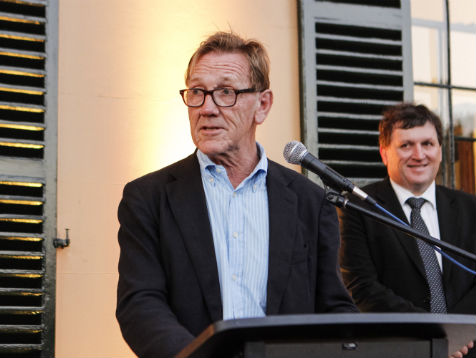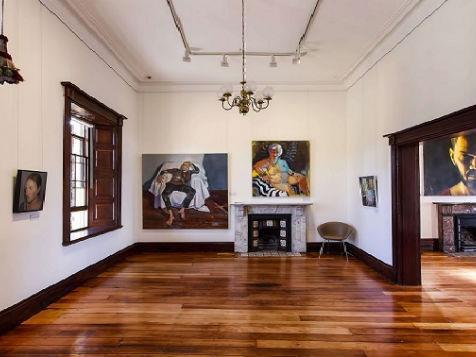Juniper Hall is to feature an exhibition of Moran Art Prize winners and finalists. Image: courtesy Doug Moran Art Prize.
Each year two prominent Australian art figures are invited to judge the winners of the Doug Moran National Portrait Prize – now regarded as one of the country’s largest celebration of portrait painting since the inception of the Prize in 1988.
Melbourne artist Lewis Miller and Australian arts luminary Edmund Capon will together nominate the 2014 winners of the Doug Moran National Portrait Prize.
For Capon, the Prize perfectly encapsulates the national obsession with portraiture. ‘One of the things that I have noticed about the Moran Prize is that it began with a more conventional outlook on the art of portrait painting. But that’s long since gone, as it now is a Prize of equal eminence to the Archibald.
‘It’s got many of the same artists entering, and in a way it’s certainly given extra life to the art of portrait painting in Australia. It’s confirmed what we all know – the art of portraiture has a long way to go. It’s actually alive, well and flourishing.’
Capon contends that two primary reasons are behind this resurgence. Firstly, the art of portrait painting – as seen within both the Moran and the Archibald – shares a long history of engaging the public with people of our time and place.
‘That’s the fascinating or interesting thing. There’s no more interesting subject or fascinating topic for the visual artist than our fellow human beings. The art of portrait painting is one of continual exploration,’ he said.
Secondly, the Doug Moran National Portrait Prize also appeals to a more eclectic arts appetite than the Archibald. ‘Critics often hail portrait paintings as an art form of earlier times. The fact is that people of our time and place, are being interpreted by contemporary artists. In a way I think Doug [Moran] was looking at it [the Prize] as an alternative.’

Edmund Capon will judge the 2014 Moran Art Prizes. Image courtesy Moran Art Prizes.
The Doug Moran National Portrait Prize as the annual painting portrait competition celebrates excellence in portrait painting and carries a cash prize of $150,000 for the winner, with the introduction this year of a cash prize of $1000 for the top 30 finalists.
Created more recently in 2007, the Moran Contemporary Photographic Prize is judged in two categories. The Open Section, judged by two professional photographers – Aidan Sullivan from Getty Images and William Long from LongShots Photography, invites both amateur and professional photographers, has a $50,000 cash prize to the winner and this year also introduces a $1000 cash prize for the top 30 finalists. The Students Section is broken down into year level tiers with separate prize pools for winning student artists and matched investment to the development of the arts within the school environment.
Capon describes the Moran Contemporary Photographic Prize as the ‘parallel story’ to the Doug Moran [National] Portrait Prize. ‘No doubt there’s a huge interest in that endeavour throughout the community. Photography is a very democratic medium and you’re more instinctive when you’re looking at a photograph.
‘In painting, you’re inevitably looking for mannerisms and techniques, which are a sign of the artist’s particular instincts. Whereas photography in a way really is magical because you’re more open-minded. You’re going to be more analytical about the work than in the art of photography,’ he said.
Capon said that the judging process for both of the Moran Prizes carry specific credentials, which ensure that the most deserving winners are selected. ‘You’re looking for a portrait that immediately has that ring of authenticity and that ring of conviction – that air of authority.
‘Portraits seem to have that inner light. Some people who deal with the particulars of anonymity – or lack of it – reveal an authentic character and an authentic personality and that’s a very subjective response.
The artist and the subject of the portrait must each be an Australian citizen or have lived in Australia for at least one year prior to the competition closing date, but it is not required that the artist’s subject be in any way well known. ‘I’d have to say we’re always looking for something that has originality to it. We’re always looking for an interest in the idea.’
Winners and selected finalists of the Moran Art Prizes will also be shown in a special exhibition at Sydney’s Juniper Hall. ‘It’s a fabulous building. It presents a few challenges in terms of hanging works in there – it’s one of those very special historical buildings and it wasn’t designed as a picture gallery, but it’s got some wonderful history. It’s a fabulous venue. It has this lovely feeling and personality.’
Running alongside the Moran Arts Prizes is the Moran Arts Foundation Student’s Photography Workshops program, which commenced in 2007 in tandem with the Moran Contemporary Photographic Prize.
Offered across 150 participating schools around Australia in urban, rural and remote communities per year, the free workshops encourage and develop photography skills within school aged children.
For any considering their application to either of the Doug Moran Art Prizes, Capon’s advice is simple: ‘Do it.’
‘You get hundreds and hundreds of entries every year. Each year with the Moran Art Prizes there is always new artists who have never shown before. Every year it’s a completely new event and for many, many artists, the Moran Prizes is the first step into public recognition. It’s one of the classic art events of the nation.’
Entries to the Doug Moran National Portrait Prize close on Friday 15 August at 4pm, along with entries to the Moran Contemporary Photographic Prizes, which close on Monday 15 September at 4pm.
Selected finalists will be presented in an exhibition at Juniper Hall, Sydney.
For full competition terms, conditions and any additional information visit the Moran Prizes website.
*Please Note: Lewis Miller has graciously stepped into replace Rick Amor as he has had to withdraw from judging due to ill health. All of us here at the Moran Arts Foundation wish him well.





